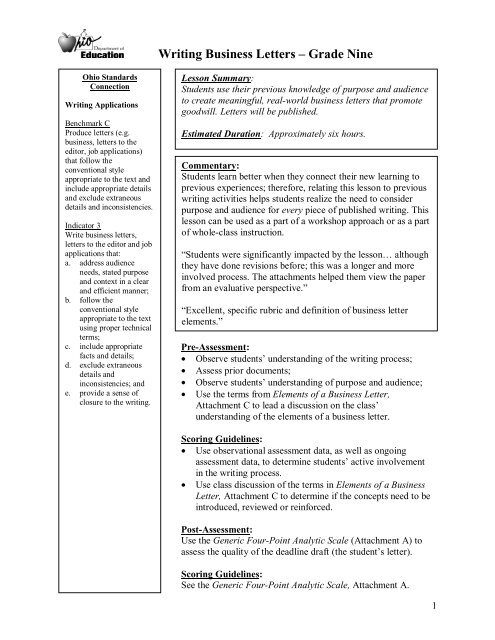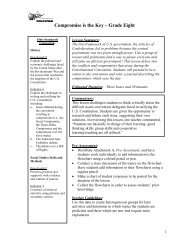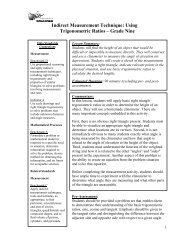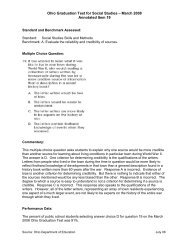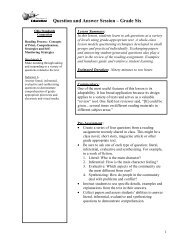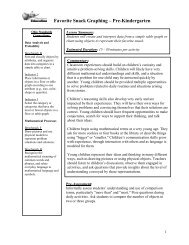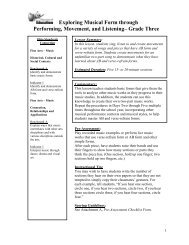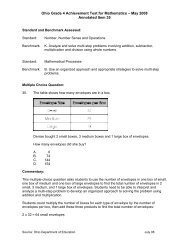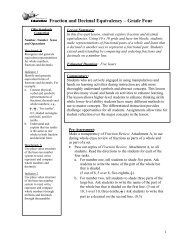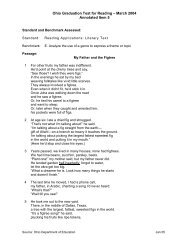Writing Business Letters â Grade Nine - ODE - Ohio Department of ...
Writing Business Letters â Grade Nine - ODE - Ohio Department of ...
Writing Business Letters â Grade Nine - ODE - Ohio Department of ...
Create successful ePaper yourself
Turn your PDF publications into a flip-book with our unique Google optimized e-Paper software.
<strong>Writing</strong> <strong>Business</strong> <strong>Letters</strong> – <strong>Grade</strong> <strong>Nine</strong><strong>Ohio</strong> StandardsConnection<strong>Writing</strong> ApplicationsBenchmark CProduce letters (e.g.business, letters to theeditor, job applications)that follow theconventional styleappropriate to the text andinclude appropriate detailsand exclude extraneousdetails and inconsistencies.Indicator 3Write business letters,letters to the editor and jobapplications that:a. address audienceneeds, stated purposeand context in a clearand efficient manner;b. follow theconventional styleappropriate to the textusing proper technicalterms;c. include appropriatefacts and details;d. exclude extraneousdetails andinconsistencies; ande. provide a sense <strong>of</strong>closure to the writing.Lesson Summary:Students use their previous knowledge <strong>of</strong> purpose and audienceto create meaningful, real-world business letters that promotegoodwill. <strong>Letters</strong> will be published.Estimated Duration: Approximately six hours.Commentary:Students learn better when they connect their new learning toprevious experiences; therefore, relating this lesson to previouswriting activities helps students realize the need to considerpurpose and audience for every piece <strong>of</strong> published writing. Thislesson can be used as a part <strong>of</strong> a workshop approach or as a part<strong>of</strong> whole-class instruction.“Students were significantly impacted by the lesson… althoughthey have done revisions before; this was a longer and moreinvolved process. The attachments helped them view the paperfrom an evaluative perspective.”“Excellent, specific rubric and definition <strong>of</strong> business letterelements.”Pre-Assessment:• Observe students’ understanding <strong>of</strong> the writing process;• Assess prior documents;• Observe students’ understanding <strong>of</strong> purpose and audience;• Use the terms from Elements <strong>of</strong> a <strong>Business</strong> Letter,Attachment C to lead a discussion on the class’understanding <strong>of</strong> the elements <strong>of</strong> a business letter.Scoring Guidelines:• Use observational assessment data, as well as ongoingassessment data, to determine students’ active involvementin the writing process.• Use class discussion <strong>of</strong> the terms in Elements <strong>of</strong> a <strong>Business</strong>Letter, Attachment C to determine if the concepts need to beintroduced, reviewed or reinforced.Post-Assessment:Use the Generic Four-Point Analytic Scale (Attachment A) toassess the quality <strong>of</strong> the deadline draft (the student’s letter).Scoring Guidelines:See the Generic Four-Point Analytic Scale, Attachment A.1
<strong>Writing</strong> <strong>Business</strong> <strong>Letters</strong> – <strong>Grade</strong> <strong>Nine</strong>Instructional Procedures:Day One1. Use the think-pair-share activity to get students thinking about goodwill. Display thequestions in Establishing Goodwill (Attachment B) on the overhead and allow students torespond to the questions individually for five minutes (Think).2. Pair students for three minutes to exchange their responses and ensure every student has ananswer to share with the entire class (Pair).3. Have students share their answers as you conduct a full class discussion about goodwill(Share). Make sure all <strong>of</strong> the questions have been answered completely and that all studentshave a working understanding <strong>of</strong> the concept <strong>of</strong> goodwill (the creation <strong>of</strong> a friendly, positivetone). Record responses on chart paper, so the entire class has a posted list <strong>of</strong> thecharacteristics <strong>of</strong> goodwill.4. Use the concept <strong>of</strong> goodwill to introduce the business letter writing lesson, emphasizing thatall successful business letters not only practice the principles <strong>of</strong> good communication butseek the goodwill <strong>of</strong> their readers.5. Provide each student with a copy <strong>of</strong> Elements <strong>of</strong> a <strong>Business</strong> Letter, Attachment C. Use anoverhead and transparency <strong>of</strong> the attachment in order to identify the elements <strong>of</strong> a businessletter.Instructional Tip:By providing the students with a copy <strong>of</strong> your overhead, Attachment C, you are able to modelnote-taking procedures students may use to ensure they understand the parts <strong>of</strong> a letter. You mayalso provide concrete examples <strong>of</strong> the different elements <strong>of</strong> a business letter as you write specificexamples on the overhead.Homework:Distribute Graphic Organizer, Attachment D. Have students complete only the first, “Example”column, before the next class. The people and businesses that make the products listed may bethe audience <strong>of</strong> the business letter. Ask students to think <strong>of</strong> a peer who did a nice thing for them.Have them write the name <strong>of</strong> the individual in the first block. Instruct the students to completethe rest <strong>of</strong> the first column this way.Day Two6. Distribute a copy <strong>of</strong> the Sample Letter, Attachment E, and ask students to individuallyidentify the elements <strong>of</strong> the letter and have them identify the parts <strong>of</strong> the letter that establishgoodwill.7. Have students check their own work as you lead the class in a review <strong>of</strong> yesterday’s lesson,using an overhead transparency <strong>of</strong> the Sample Letter, Attachment E to identify the elements<strong>of</strong> a business letter and characteristics <strong>of</strong> goodwill.8. Review the broad categories (purposes) for writing: informing, explaining, persuading,exploring and entertaining.9. Explain that business letters may have some <strong>of</strong> the same purposes. Use the top half<strong>of</strong> an overhead transparency <strong>of</strong> Three General Types <strong>of</strong> <strong>Business</strong> <strong>Letters</strong>, Attachment F toidentify three broad categories for business writing.10. Divide the class into groups <strong>of</strong> three. Have each person in the group take one <strong>of</strong> the threecategories (positive, negative, persuasive) and generate a list <strong>of</strong> specific examples for each2
<strong>Writing</strong> <strong>Business</strong> <strong>Letters</strong> – <strong>Grade</strong> <strong>Nine</strong>category. Students may use some <strong>of</strong> their ideas from last night’s homework for inspiration.Have each group record its list on a blank transparency to share with the class.11. After groups work individually, have each group present its examples to the class.12. Use the second part <strong>of</strong> Three General Types <strong>of</strong> <strong>Business</strong> <strong>Letters</strong>, Attachment F to discussorganization strategies for each type <strong>of</strong> letter. Use the specific examples from the listsstudents generated in step 10.Homework:Have students complete the rest <strong>of</strong> their Graphic Organizer, Attachment D, by identifyingdifferent types <strong>of</strong> letters they might write with regard to the specific products and/or servicesthey listed.Day Three13. Distribute copies <strong>of</strong> Establishing Goodwill Through Positive Tone, Attachment G and havestudents individually rephrase the sentences in order to generate more goodwill (create amore positive tone).14. Divide students into groups <strong>of</strong> four to share their responses. If necessary, as an entire classcomplete a sentence or two that seems especially difficult.15. Have students choose one <strong>of</strong> the products or services from their Graphic Organizer,Attachment D, to write and mail a real letter.16. Distribute and read with your students Attachment A, Generic Four-Point Analytic Scale andAttachment H, Getting Started on <strong>Letters</strong>, Attachment H. Remind students to use theElements <strong>of</strong> a <strong>Business</strong> Letter, Attachment C, and the Sample Letter, Attachment E, to assistthem in their writing.17. Help students determine the correct mailing address for their letter (using phone books,Internet or product packaging).18. Follow your established patterns/protocols for working through the writing process.As needed, pass out the Generic Revision Checklist for <strong>Business</strong> <strong>Letters</strong>, Attachment I, andsend students to the computer (or writing center) to type their deadline draft.Day Four19. Provide individual instruction and assistance, as needed, as students continue to work ontheir letters. Use self- and peer-evaluation strategies that have been effective in the past.20. Supply students with samples <strong>of</strong> correctly addressed letters in order to model the correctformat.21. Remind students to turn in the following pieces <strong>of</strong> evidence <strong>of</strong> their writing process:• Two deadline drafts (one to assess and one to mail),• All working drafts,• One self-evaluation, and• One peer-evaluation.Instructional Tip:Have envelopes available in class so students can address the envelope and mail the letter.3
<strong>Writing</strong> <strong>Business</strong> <strong>Letters</strong> – <strong>Grade</strong> <strong>Nine</strong>Differentiated Instructional Support:Instruction is differentiated according to learner needs to help all learners either meet the intent<strong>of</strong> the specified indicator(s) or, if the indicator is already met, to advance beyond the specifiedindicator(s).• Allow extra time for drafting for students who need it.• Provide a hard copy <strong>of</strong> notes taken in class, as necessary.• Encourage students who need more <strong>of</strong> a challenge to write the persuasive letter and thenemphasize the subtleties <strong>of</strong> persuasion.Interdisciplinary Connections:If students are currently working on a research project in another class, compose a letter <strong>of</strong>inquiry to ask for some <strong>of</strong> the information you need. Begin thinking about this assignment bymaking a list <strong>of</strong> things you want to know.Social StudiesSkills and Methods StandardBenchmark: B. Use data and evidence to support or refute a thesis.Indicator: 4. Develop and present a research project including…. collection <strong>of</strong> data.Materials and Resources:The inclusion <strong>of</strong> a specific resource in any lesson formulated by the <strong>Ohio</strong> <strong>Department</strong> <strong>of</strong>Education should not be interpreted as an endorsement <strong>of</strong> that particular resource, or any <strong>of</strong> itscontents, by the <strong>Ohio</strong> <strong>Department</strong> <strong>of</strong> Education. The <strong>Ohio</strong> <strong>Department</strong> <strong>of</strong> Education does notendorse any particular resource. The Web addresses listed are for a given site’s main page,therefore, it may be necessary to search within that site to find the specific information requiredfor a given lesson. Please note that information published on the Internet changes over time,therefore the links provided may no longer contain the specific information related to a givenlesson. Teachers are advised to preview all sites before using them with students.For the teacher: overhead projector, photocopies <strong>of</strong> all attachments, overhead transparencies <strong>of</strong>the handouts, overhead markers, blank transparencies, model envelopesFor the students: internet access, yellow pages, white pages, handouts, blank transparencies,envelopesVocabulary:• audience• block style• buffer• deadline draft• goodwill• motivate• purpose• working draftTechnology Connections:• Use the overhead for instructing the whole group, modeling and reporting out.• Use word processors for working drafts and deadline drafts and addressing envelopes.4
<strong>Writing</strong> <strong>Business</strong> <strong>Letters</strong> – <strong>Grade</strong> <strong>Nine</strong>• Use the Internet to research contact names and addresses.Research Connections:Arter, Judith and Jay McTighe. Scoring Rubrics in the Classroom: Using Performance Criteriafor Assessing and Improving Student Performance. Thousand Oaks, Calif.: Corwin Press, 2001.An analytical trait rubric divides a product or performance into essential traits or dimensions sothey can be judged separately—one analyzes a product or performance for essential traits. Aseparate score is provided for each trait.Analytical rubrics manage to:• Judge complex performances involving several significant dimensions;• Break performances into traits in order to more readily grasp the components <strong>of</strong> quality and• Provide more specific feedback to students, parents and teachers.Lyman, F. (1981). "The responsive classroom discussion." In Anderson, A. S. (Ed.),Mainstreaming Digest, College Park, Md.: University <strong>of</strong> Maryland College <strong>of</strong> Education.Think-Pair-Share is one <strong>of</strong> the most common cooperative learning structures. It is extremelyversatile because it can be used for higher-level thinking as well as basic review and recall. It isimportant to follow the steps exactly to avoid "group work" pitfalls. In this structure, the teacherwill ask students to think about a topic, have them pair with a partner to discuss it, and finallyhave them share their ideas with a group.General Tip:Providing models, as well as making the purpose <strong>of</strong> the writing real to the students, is the bestway to ensure quality results. The writing must be purposeful and meaningful or else it’s justanother assignment.Attachments:Attachment A, Generic Four-Point Analytic ScaleAttachment B, Establishing GoodwillAttachment C, Elements <strong>of</strong> a <strong>Business</strong> LetterAttachment D, Graphic OrganizerAttachment E, Sample LetterAttachment F, Three General Types <strong>of</strong> <strong>Business</strong> <strong>Letters</strong>Attachment G, Establishing Goodwill Through Positive ToneAttachment H, Getting Started on <strong>Letters</strong>Attachment I, Generic Revision Checklist for <strong>Business</strong> <strong>Letters</strong>5
<strong>Writing</strong> <strong>Business</strong> <strong>Letters</strong> – <strong>Grade</strong> <strong>Nine</strong>Attachment AGeneric Four-Point Analytic ScaleCircle the numbers that most clearly indicate how well the paper meets the stated criteria. Total thecircled numbers.1= The paper does not achieve the standard.2= The paper indicates some effort to meet the standard but with little success.3= The paper indicates serious effort to meet the standard and is fairly successful.4= The paper clearly meets or exceeds the standard.Writer ______________________________ Title ________________________________________ContentThe writing is likely to interest the intended audience. 1 2 3 4The writing has a clear purpose and achieves it. 1 2 3 4The writing is unified and coherent. 1 2 3 4The subject has been explored and developed completely. 1 2 3 4The writing contains no unrelated or distracting details. 1 2 3 4OrganizationThe writing has a clear structure. 1 2 3 4Ideas and details are arranged in an effective order. 1 2 3 4Connections between and among ideas are clear. 1 2 3 4StyleLanguage suits the topic, audience and purpose. 1 2 3 4Sentences are graceful and not awkward. 1 2 3 4Wordiness, clichés and jargon are eliminated. 1 2 3 4The writer’s meaning is clear throughout. 1 2 3 4Grammar, Usage, Spelling and MechanicsThe paper is free <strong>of</strong> problems in grammar and usage. 1 2 3 4The paper is free <strong>of</strong> problems in spelling and mechanics. 1 2 3 4The paper follows block format exactly. 1 2 3 4Total points ____________/606
Questions to answer:1. What is goodwill?<strong>Writing</strong> <strong>Business</strong> <strong>Letters</strong> – <strong>Grade</strong> <strong>Nine</strong>Attachment BEstablishing Goodwill2. How can you create goodwill?3. What are the principles <strong>of</strong> good communication?7
<strong>Writing</strong> <strong>Business</strong> <strong>Letters</strong> – <strong>Grade</strong> <strong>Nine</strong>Attachment CElements <strong>of</strong> a <strong>Business</strong> LetterHeading—Use the complete address (no abbreviations) <strong>of</strong> the sender as a returnaddress.Dateline—Date the letter (day, month and year), with no commas and no spacebetween the heading and the dateline.Inside Address—Use the correct name, title and address <strong>of</strong> the person to whomyou are writing; this name should match the name used in the greeting.Greeting—Use “Dear,” a courtesy title like Mr., Mrs. or Dr., and a colon.Body—Keep your letter between 2-6 paragraphs on average. Single space withinthe body paragraphs and double space between paragraphs. Block-form lines alltext on the left margin and does not require indentations <strong>of</strong> paragraphs.Closing—Use a friendly but pr<strong>of</strong>essional ending like “Sincerely” or “Yours truly.”Follow your closing with a comma.Spacing—Leave three lines between the closing and your typed name in order tocreate a space in which to sign your name.Typed Name—Type your name on the fourth line after your closing.8
<strong>Writing</strong> <strong>Business</strong> <strong>Letters</strong> – <strong>Grade</strong> <strong>Nine</strong>Attachment DGraphic OrganizerExample Positive Negative PersuasivePerson whodid a kindthing for youPerson whodid a kindthing for youPerson whodid a kindthing for youProduct youuseProduct youuseProduct youuseService youreceiveService youreceiveEstablishmentyou frequentEstablishmentyou frequent9
<strong>Writing</strong> <strong>Business</strong> <strong>Letters</strong> – <strong>Grade</strong> <strong>Nine</strong>Attachment ESample LetterYour addressCity, State ZipMonth Day YearDear Parents:We enjoy having your child on our soccer team.Please pick up your child from soccer practice by 5:30 p.m. Our coaches have othercommitments—some to their families, some to other teams—and they might be late if you arenot on time.Thank you for your cooperation. If you have any questions or concerns, please contact us at ….Sincerely,Typed Names <strong>of</strong> Signatures, Officers <strong>of</strong> Local Youth Soccer League10
<strong>Writing</strong> <strong>Business</strong> <strong>Letters</strong> – <strong>Grade</strong> <strong>Nine</strong>Attachment FThree General Types <strong>of</strong> <strong>Business</strong> <strong>Letters</strong>Positive MessagesNegative MessagesPersuasive MessagesPositive Messages• State good news first.• Provide needed details.• Close on a friendly note.Negative Messages• Use a buffer first.• Explain the reason for the negative news.• State the negative news.• Close in a friendly manner.o Offer a constructive suggestiono Look to the futureo Suggest something, if possibleo Ask for something (complaint letters)Persuasive Messages• Capture your reader’s attention.• Sell your product or service.• Motivate your reader to action.11
<strong>Writing</strong> <strong>Business</strong> <strong>Letters</strong> – <strong>Grade</strong> <strong>Nine</strong>Attachment GEstablishing Goodwill through Positive ToneRephrase or rearrange the following sentences in order to create a more positive tone and,therefore, generate more goodwill.1. If you attend the inaugural meeting, I’ll buy you dinner on Friday.2. You were told to be at work by 9:00!3. You claim to have had car trouble on the way home?4. We cannot allow you to make failing grades.5. You have had more than enough time to pay the amount you owe.6. If you cannot attend rehearsals on time, then you cannot be in the show.7. Our T-shirts will not shrink.8. You will not encounter any problems with our supplemental materials.12
<strong>Writing</strong> <strong>Business</strong> <strong>Letters</strong> – <strong>Grade</strong> <strong>Nine</strong>Attachment HGetting Started on <strong>Letters</strong>Follow these steps when getting started with your letters:1. Determine the type <strong>of</strong> letter you will be writing—positive,negative or persuasive.2. Determine what information (details, examples, facts,figures, experiences) you need. What questions should yourletter answer?3. Take notes on the details you have gathered. Gather factsregarding the background, problems and/or difficulties <strong>of</strong>your experience. Determine to whom you will be writingand the correct address.4. Double-check the accuracy <strong>of</strong> your information.5. Follow the organizational plan for each type <strong>of</strong> letter.6. Organize your notes following the appropriateorganizational plan.13
<strong>Writing</strong> <strong>Business</strong> <strong>Letters</strong> – <strong>Grade</strong> <strong>Nine</strong>Attachment IGeneric Revision Checklist for <strong>Business</strong> <strong>Letters</strong>Does my letter contain the correct letter parts? Yes NoDo I consistently follow block format? Yes NoIs my tone positive, even in a “bad news” letter? Yes NoDoes my letter promote goodwill? Yes NoIs my information accurate, clear and concise? Yes NoAm I ready for editing and peer review? Yes No14


